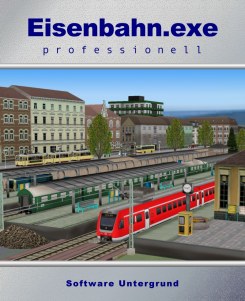This - loosely defined - category takes its starting point from the idea of a model railway layout. At one extreme are programs that are little more than cad tools for planning layouts to build in the real world; at the other powerful 3D simulation tools.
1 Trainz
The Australian Trainz seems to be somewhere between msts and the “virtual model” category. I wasn’t impressed with the demo of the original Trainz, which was definitely more model than simulator. However, it's still going strong, and they seem to release new versions at regular intervals, improving all the time. Unlike most other rail software, they produce versions for the Mac and even the iPad.
They have always had pretty good graphics and a very user-friendly layout editor, well-integrated with the program. There’s lots of “play value”, with interactive industries (power stations that only supply electricity when you bring them trainloads of coal, etc.) and the possibility to give your drivers instructions interactively. However, the layouts supplied sometimes have a “model railway” feel to them.
Signalling and train physics were not up to the standard of MSTS, but have developed a bit since those days. The system that allows you to have a number of “ai drivers” and give them simple instructions (“Drive to power station; unload coal”) is a very nice feature, although it takes some trial and error to get it to work, and there still doesn't seem to be any way to take over the role of the signaller and sort out conflicts.
2 Eisenbahn.exe Professionell (a.k.a. Railroad X)
This commercial Windows program seems to have had a following in German-speaking countries for quite some time, and has been through several major versions. I've played around quite a lot with the first DirectX version, Eisenbahn.Exe Professionell, which appeared at the end of 2001. It was preceded by a very popular OpenGL version, EEEC, which still has a minor cult following (see below). The current version (early 2015) is EEP 11. The program hasn't changed fundamentally since 2001: they have added a few minor features and cleaned up the UI a little bit (although it's still rather clunky). The important changes have mostly been to the graphics. It was only in EEP 11 that they finally added a scripting system.
The program doesn't seem to have been marketed much outside the German-speaking area, although there is a supposedly-English version of the previous release (EEP X, late 2013) under the name "Railroad X", available through Steam. It's a classic textbook example of why you should pay a real translator and not rely on Google Translate if you want to convert a complex piece of software into another language. EEP has a steep learning curve under any circumstances, and it doesn't help if the menu items and help text are a mixture of unintelligible mistranslation and residual bits of German. Not recommended unless you already know your way around. You will need a basic knowledge of the German language to get anything out of the program, and you will find that practically all the stock and scenic models available are based on German, Swiss or Austrian prototypes anyway.
When I tried it, signalling was the major weakness: the signals worked exactly like those on a model railway (i.e. each could be associated with one or more “contacts” that set it to danger when a train passes, and others that clear it. There is no built-in interlocking between signals. All signals were stop signals, paired with a distant that copies the indication of the home signal. Ingenious users have discovered that you can get some degree of automatic control by using the contacts on the railway to operate signals and points for a car running around in circles somewhere else, which in turn operates the railway signals. There are plenty of tutorials around to show you how to do this, but it is somewhat tedious to set up. On the positive side, you will really understand signalling by the time you've built your own interlocking.
Unlike Rail3D and Trainz, where all track consists of Bezier curves, EEP forces you to think in terms of fixed track sections that are either straights or arcs of user-defined angle and radius. That makes it easier to build neat-looking model railway-style track, but it means that you have to think quite carefully about what you are doing. There are macros available for standard configurations like ladders and crossovers.
Having said that, it is an entertaining program, with plenty of play-value, and it's clearly possible to get good results with it, particularly if you like the German style of model railway layout where every inch of the baseboard is covered in track. If you're not too bothered about automation, it's easy to put together an attractive-looking layout with the bits you get in the package. A nice aspect is the support for narrow gauge and for trams, buses, and U- and S-Bahn; you can also have cars and boats. The original EEP still runs very nicely on my not-exactly-state-of-the-art laptop under Windows XP.
The main problem with it, compared to MSTS and Trainz (the obvious competitors, even if they are quite different kinds of program), is always the very restrictive content development concept: third-party content had to be distributed through Software Untergrund (nowadays through Trend), with almost all of it being payware. A kind of App Store model avant la lettre.
- Software Untergrund’s eisenbahn.exe site (not updated since about 2003)
-
Trend's Eisenbahn.Exe shop (for more recent versions)
- Detlev Schmidt and Werner Köhler have breathed new life into the old eeec with an add-on called View-eeec. See Detlev’s EEEC pages (the models available on his site include conversions of some of my Rail3d models)


